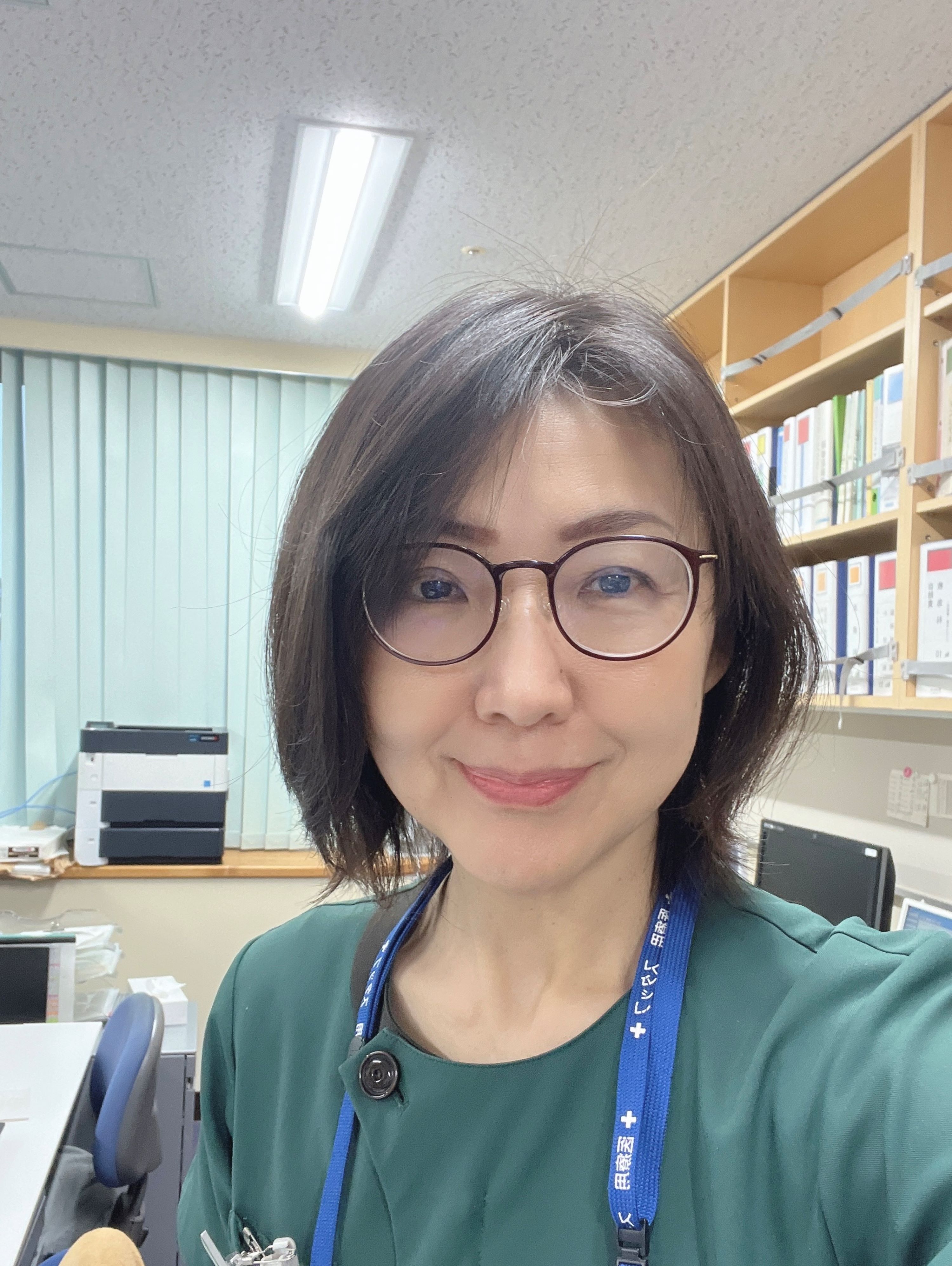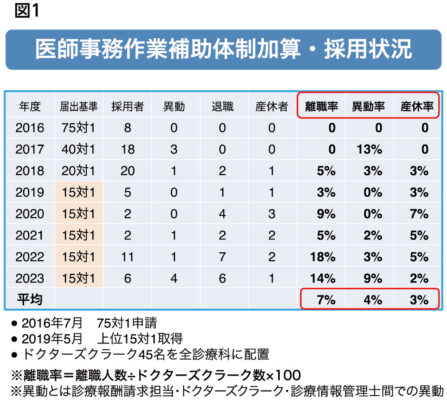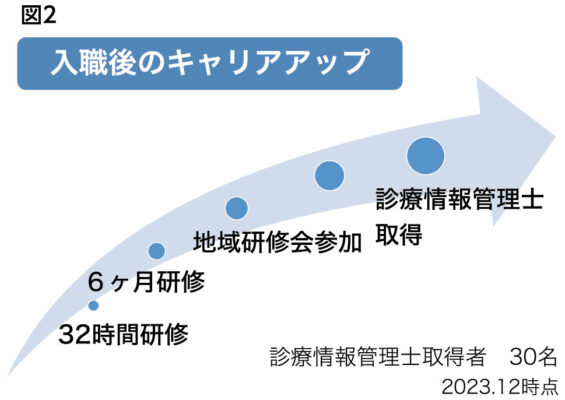
Director of Medical Information Department, University of Miyazaki Hospital
Medical Affairs Division Specialist
Shiori Hirashima
A qualified social worker, she has experience as a social worker at a medical institution and as a career consultant for the government. During her time as a teacher at a medical record management training school, she wanted to be involved in the use of medical record management, so in 2015 she joined the Medical Affairs Department of the University of Miyazaki Hospital as a medical record manager. She has been in her current position since 2021.
At the University of Miyazaki Hospital, medical administrative assistants are called doctor's clerks and are assigned to all medical departments to promote task shifting for doctors and collaboration between medical departments. We spoke to Shiori Hirashima, head of the hospital's medical information office, about the work, recruitment, and training of doctor's clerks.

Miyazaki University Hospital (632 beds: 596 general beds + 36 psychiatric beds) is the only specialized hospital in the prefecture. It has 1,540 employees, including 216 administrative staff, of which 50 are doctor's clerks (as of June 2023).
The doctor's clerk's job is to assist with document creation, input into medical records, clerical work related to improving the quality of medical care, and administrative work. Since our hospital is a core clinical training hospital with a postgraduate clinical training center and also educates doctors, the doctor's clerk does not take over all of the records, but rather plays a role that makes the ability to read medical records their strength, such as reminding doctors to create discharge summaries and checking doctors' actions following image diagnosis and test results. Of course, we also take over clerical work such as creating medical certificates. Recently, we have been focusing on inputting explanation records at the time of informed consent, and in 2023, we will input 11% of the total and 43% at the emergency medical center, supporting doctors to focus on their original medical practice.
In 2016, our hospital began offering guaranteed treatment as a designated full-time hospital employee upon obtaining a medical record manager qualification. From that year, the basic hospital admission fee for designated functional hospitals also became eligible for the physician clerical work assistance system surcharge I, and the hospital wanted doctor's clerks to play an active role, taking into consideration the task shifting of doctors. Previously, administrative assistants were fixed-term positions, so there was a high turnover rate and it was difficult to improve the quality of work. In order to create a high-quality work environment, we decided to hire good people and have them work for a long time.
As an introductory trial, we assigned one person each to the outpatient departments of obstetrics and gynecology and orthopedics. Both departments are headed by the hospital director and deputy director, and it was thought that it would be easier for the doctors who direct the direction of the entire hospital to understand the system. In addition, while the orthopedics examination rooms are private but open, making it easy for doctor's clerks to deal with patients, the obstetrics and gynecology department also wanted to verify whether it would be possible to accommodate doctor's clerks in private rooms due to considerations of privacy. At this time, we decided to have them wear scrubs instead of office uniforms so that patients would recognize them as medical staff.
At the same time, the doctor's clerk duties for these two medical departments were compiled into a manual so that they could be applied to any medical department, and the assignments were expanded in line with the flow of medical treatment, to the entire outpatient department, medical departments such as each center, and wards, achieving assignment to all medical departments in three years (see Figure 1). Just before the assignment, some doctors said things like "If I'm going to give approval, it's quicker to do it myself," but by clarifying the duties and having a doctor's clerk always nearby to provide reminder support, doctors felt reassured and I think this spread understanding within the hospital. The doctor's clerks act as a flexible liaison.

The conditions for applying for a doctor's clerk are to have a medical record manager qualification or experience working at a medical institution. If you do not have a medical record manager qualification, we will hold an exam preparation course after hiring you. Many people have taken classes while working and passed. Some people have also acquired beginner and intermediate cancer registration practical qualifications in order to advance their careers. After hiring you, you will receive 32 hours of training while working for 6 months, which is the requirement for calculating the medical fee for the medical administrative work support system surcharge (see Figure 2). This training is taught by doctors, chief technicians of the pharmacy, laboratory, radiology, and nutrition management departments, medical safety management department, medical information system office, and medical affairs department staff, and deepens your understanding of the characteristics of medical treatment and the structure of the hospital.
In addition, we encourage doctor's clerks with more than five years of experience to participate in the skill-up training course for doctor's clerks hosted by the Miyazaki Prefecture Medical Association, as well as the medical administrative assistant instructor training course hosted by the Japan Society for Healthcare Management. Furthermore, we accept doctor's clerk interns from medical record management schools. By being in the position of teaching students, we have the opportunity to reflect on and examine the role of a doctor's clerk.

In 2021, the Medical Records Management Department was established, allowing personnel transfers between doctor's clerks, medical record managers, and medical fee claim staff. This is one of the roles of the Medical Affairs Department, which is to monetize the efforts of the medical staff, and aims to prevent turnover by developing human resources and placing the right people in the right positions, leading to the revitalization of the organization.
To ensure that all doctor's clerks have experience as a leader or team member, we have established a team leader system (for general affairs, operations, education, and management) and an operation leader system (for medical certificates, forms, the medical information support team, and the medical information sharing and transmission confirmation office).
Even if artificial intelligence (AI) is incorporated into work in the future, we expect that the work of doctor's clerks, who connect multiple professions, will become increasingly important. However, as the task shift from doctors expands the scope of work for doctor's clerks, there is a possibility that they will have difficulty recruiting due to a labor shortage, so digital transformation (DX) of work is necessary. DX requires people who have the skills to visualize work, promote and execute DX, and can flexibly approach those around them. We believe that it is the challenge and responsibility of managers to develop DX talent and create an environment where they can take on challenges.